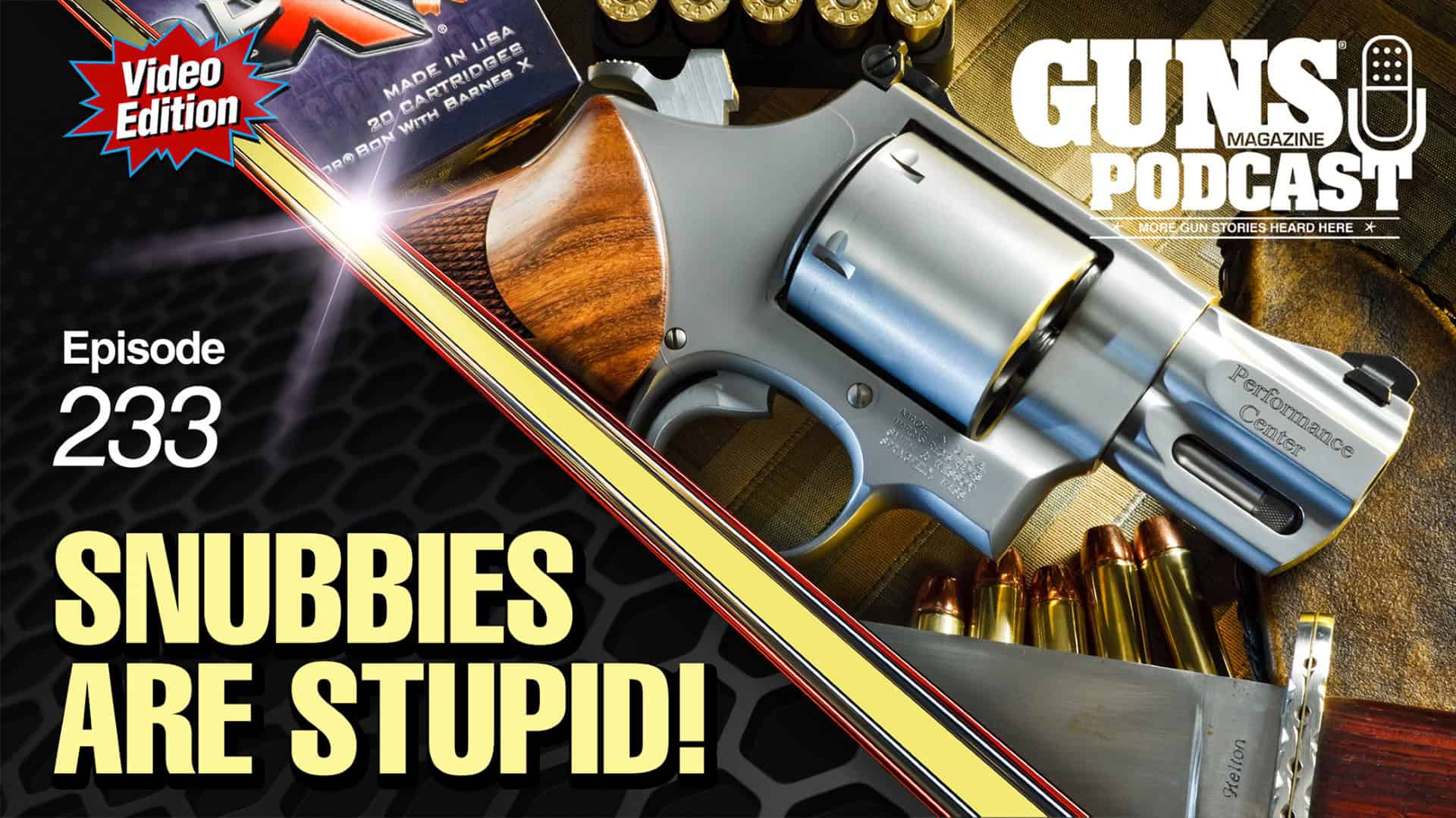The Mouse That Roars
I Love Itty-Bitty Guns!
I’ve always had an outsized fascination with teeny-weeny guns. I guess it’s primitive human intrigue at something which can inflict such tremendous damage and project power far in excess of its meager size. The smaller a gun gets, the more fascinated I become. This is one of many reasons I dearly love the smallest of the small, as exemplified by the North American Arms (NAA) micro-revolvers.
I’ve carried all sorts of “mouse guns” both on- and off-duty and continue to do so. However, I’ll be the first to admit — like spiritous beverages and feisty women — they’re not for everyone. In fact, I’ll even put them in the category of “Do as I say, not as I do” because you’ll rarely hear me espouse the virtues of miniature guns, even though there is likely one in my pocket. Let’s examine this hypocritical dichotomy.
Boundaries
The reason I hesitate to recommend mouse guns as a panacea against two-legged danger is simple: the margin of error is, well, marginal.
While lots of people love to endlessly argue the relative power of this or that pistol, when you get right down to it, a handgun is an underpowered weapon system. We carry them because they’re small and easily concealed compared to long guns. The tradeoff is “stopping power,” a misleading term we’ll use anyway in the non-technical, broader sense of ‘how quickly does a bad person cease and desist when blasted in a vital area.
Basically, if you want a real, bet-your-life-on-it one-shot “stop,” you need to use a large-caliber rifle (or shotgun at close range). All other things being equal, a bad person hit in a vital area with a heavy rifle or rifled slug will have all their lifetime memberships canceled immediately, muy pronto, do-not-pass-go versus a “maybe,” “possibly,” or “eventually” kinda-thing with a pistol. In other words, if you know you’re going to a gunfight, you want to take a rifle or shotgun. Unfortunately, we don’t get to make those kinds of informed decisions ahead of time — usually — so we carry around a pistol.
Even when you’re talking a hand cannon, size still matters. Nobody is arguing the .44 Magnum isn’t far more effective (generally) than a .25 ACP, but the tradeoff is concealability, carry-ability and controllability. From there, the difference between strata becomes grayer. The .25 can be easier to shoot but is also less harsh on the terminal target. The .44 is harder to carry and literally a handful to shoot, but you sure don’t want to end up on the receiving end. Which is “better?” It depends on about a million other factors, each of them unique to the individual person and situation. This is where the mouse gun enters the fray.
Words of Wisdom
I love to quote the old chestnut, “The first rule of a gunfight is to have a gun,” because it’s true. Even the guy I know who is a world-class knife expert says, “The proper response to a blade is a gun.” While I wouldn’t voluntarily choose to whip out my .22 NAA mini-revolver in the face of a machete-wielding meth head, it’s a darn sight better than using my non-world-class bare hands or even a big rock. Therein lies the gist of why I carry those teeny-weeny little guns.
Back in the real world, I like tiny guns because they can literally be carried hidden anytime, anyplace where legal, aside from the nudist colony. If you’re running or working in the yard wearing only a pair of gym shorts and a t-shirt, you can still be armed. Same for church, meetings and other places where carrying concealed becomes more challenging.
Even better, if you’re carrying a ‘real’ gun for your ‘heavy work,’ it’s mighty easy to carry a mini-gun as a backup. Is this as good as carrying another similar-sized gun in the same caliber using the same magazines? Of course not! But I can count on one hand the guys I know who habitually carry two (or three) guns, and most of them are instructors who might look foolish if ever challenged on why they aren’t packing a dozen firearms on their person.
For the rest of us ‘real earth people,’ a mini-gun splits the difference. It’s better than being forced to whip out your trusty pen knife if your main gun goes ‘pffft,’ but certainly not as good as a second major-caliber firearm. The question you need to answer is — image and ego aside, what factors are important to you in daily life?
In my case, where my ego was destroyed years ago in a tragic television filming incident, I consider practicality and comfort the most important decision points. This is based on the proven idea that a more uncomfortable gun might just get left behind because the normal human temptation of, “I’m just running to the gas station.”
Personally, I carry a single 9mm or .45 ACP about 99% of the time I’m outside my house, along with at least one reload, a knife and a flashlight, along with back-ups to each within a few feet. I’ll then often add my NAA .22 Magnum revolver to the mix.
In situations where my educated threat assessment goes from “unknown” to “why the heck are you even going there?” I’ll go ahead and carry a second ‘major’ handgun and reload. My little .22 Mag also goes along for the ride, making her my third gun, but such times are fairly rare.
Practical Matters
If you have decided a mini-gun fits your needs, keep a couple of facts in mind. First of all, are the inarguably lousy ballistics.
According to published data, Federal Personal Defense Punch Rimfire .22 Magnum defensive ammo with a 45-grain bullet leaving a 2” barrel at 1050 fps generates right around 100 ft-lbs. of energy. The same round in .22LR and 29-grain bullet give us around 75 ft-lbs. of muzzle energy. Foot-pounds of energy do not translate 1:1 in terms of lethalness, but you can draw some inference about how ineffective the rounds are at quick incapacitation when you look at the numbers. Compare this to a 124-grain 9mm round at 1150 fps, punching in around 365 ft-lbs. Can we all agree the mouse guns don’t have much in the way of “wow factor” for their ballistics?
Fortunately, they do have penetration on their side. The Federal Personal Defense Punch rounds are engineered to penetrate all the way to the good stuff and do irreparable harm. I can’t find the charts right now, but folks who have tested them in gel were astounded to see the things just keep going and going, like that battery rabbit.
Minimal energy but good penetration means one strategy: shoot for the head. Even a pencil can be lethal when jammed into the eyes, ear hole or sinuses, so if you need to stop somebody with a mouse gun, these are your targets. Add in the short-barrel (less bullet velocity and insignificant sight-radius), tiny trigger, minuscule grip, and general ‘fumbleness’ of a mini-gun mean these are close-range, last-ditch, near-contact type of weapons. This also means escape and evasion should be considered at least as important as skill at arms with a mini-gun. Don’t ever plan on hitting a bad guy at 25 yards and expect a .22 Magnum to drop them on the spot, but you certainly should actively plan on finding a way to avoid such a situation before it happens.
My mouse guns are intended for the odds-against-odds moment where my main gun is lost, empty or completely inoperable, I’m utterly cornered and the bad guy is attacking at arm’s length. Only then would I consider producing my little surprise and doing something unspeakable to an eye socket or ear hole.
In those exceedingly rare cases, I’d be more than glad to have a roaring mouse in my pocket.
Related Links:
• North American Arms, www.northamericanarms.com
• Federal Ammunition, www.FederalPremium.com
• Speer Ammo, www.Speer.com
• Tactical Target Systems, www.tacticaltargetsystems.com










